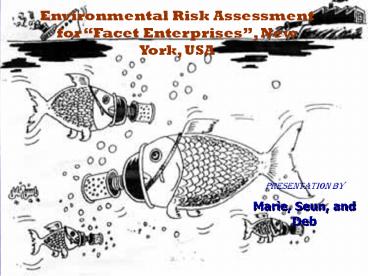Environmental Risk Assessment for - PowerPoint PPT Presentation
Title: Environmental Risk Assessment for
1
Environmental Risk Assessment for Facet
Enterprises, New York, USA
Presentation by Marie, Seun, and Deb
2
Flow of presentation
- Introduction Chemicals of Concerns Exposure
Assessment Conclusions
3
Introduction Company History
- An active manufacturing facility occupying 31
acres in the Village of Elmira Heights, Town of
Horseheads, Chemung County, New York EPA region
II, Site ID NYD073675514 1895 Started with
producing bicycles later produced various
industrial and motor parts such as starters,
clutches, spark plugs etc World war II time
fuses, 20 millimeter guns, magnetos, aircraft
cannons, and fuel pumps were manufactured
on-site Plant 2 started manufacturing in 1941
4
Introduction Company History (Contd.)
1895 Eclipse Incorporated 1929 to 1976,
Bendix Corporation 1976, Facet Enterprises
assumed ownership of the facility Later changed
to Purolator Products
5
Introduction Site Description
6
Introduction Site Description (Contd.)
7
Introduction Site Description (Contd.)
- Nearest residence 80 feet to the south Total
population at these three sites is 75,000.
Residential areas southeast drained by storm
swears west and southwest drained by swear that
connects to Mays Creek Ground water was used for
drinking purposes
8
Introduction Site Characterization (Contd.)
- The electronic wastes produced by the industry
was dumped in the waste pit Waste water was
drained into the near by creek
9
Data collection and evaluation chemicals of
concern at the site
Chemicals detected during sampling
Aroclor 1248 Benzo(g,h,i) perylene Dibenz(a,h)anthracene Naphthalene
Aroclor 1254 Cadmium Dibenzofuran Nickel (soluble salts)
Arsenic (inorganic) Chromium (III) Dichloroethene, 1,1 Pentachlorophenol
Benzo(a)anthracene Chrysene Indeno(1,2,3- cd) pyrene Phenanthrene
Benzo(a)pyrene Cyanide (free) Lead (and compounds) (inorganic) Thallium
Trichloroethane, 1,1,1- Vinyl Chloride
10
Data collection and evaluation chemicals of
concern at the site
Health effects of chemicals detected during
sampling (Carcinogens)
Aroclor 1248 Carcinogen Liver cancer
Aroclor 1254 Carcinogen Biliary tract
Arsenic (inorganic) Carcinogen Lung cancer
Benzo(a)anthracene Probable Carcinogen
Benzo(a)pyrene Probable Carcinogen
Cadmium Carcinogen Lung cancer
Chromium (III) Carcinogen Lung cancer
Vinyl Chloride Carcinogen Liver cancer
Dichloroethane 1,1 Possible Carcinogen
Indeno(1,2,3- cd) pyrene Possible Carcinogen
Nickel Carcinogen Lung cancer
11
Data collection and evaluation chemicals of
concern at the site
Health effects of chemicals detected during
sampling (Non carcinogens)
Dibenz(a,h)anthracene Reproductive system
Dibenzofuran Skin, eyes, and nose irritation
Pentachlorophenol Liver and kidney
Naphthalene Red blood cells
Lead (inorganic) Nervous and blood system
Thallium Nervous, lung, and kidney
Phenanthrene Skin
Trichloroethane, 1,1,1- Liver, kidney, and liver system
Benzo(g,h,i) perylene Reproductive system
Chrysene Reproductive system
Cyanide Reproductive system
12
Exposure and toxicity assessment
Exposure pathways
Offsite contamination
Onsite contamination
Outdoor air
Soil and sediment contamination
Potable water contamination
Surface water contamination
Soil and sediment contamination
13
Exposure and toxicity assessment (Contd.)
Assumptions !!!!!!!!!!!!_at__at__at__at__at__at__at_
- All groups had equal chances of being affected
by the contaminants Ground water was the source
of drinking water supply No threat from surface
water No threat from indoor air to the
residents Contaminated water was used in all
industrial processes Soil and sediment posed
equal risk and are not cumulative Water
treatment facility processes did not reduce the
contaminant level
14
Results Cancer risk for industrial workers
15
Results Non cancer risk for industrial workers
16
Results Pathway comparison for industrial
workers
17
Results Offsite adult cancer risk of residents
18
Results Offsite adult non-cancer risk for
residents
19
Results Offsite children cancer risk
20
Results Offsite children non cancer risk
21
Results Pathway analysis for offsite exposure
22
Conclusions
- Ingestion from soil and sediment possess the
highest exposure pathways The soil and sediment
are highly contaminated and are the primary
residue of most of the waste dumped by the
company Dibenz(a,h)anthracene posed the
largest cancer risk to residents while Chyrsene
was culprit for the non-cancer. Industrial
workers were mostly exposed to arsenic, and
arsenic contamination posed the greatest hazard
to arsenic.Most of the contaminants were
carcinogen thus making the carcinogenic risk
high while the non-cancer risk was non existent
23
References
http//www.atsdr.cdc.gov/HAC/PHA/facet/fac_p4.html
APPENDIXBhttp//www.epa.govDr. R.
Authenrith (verbally) (Professor Civil
Engineering)Abhi ( smart risk operator)
24
Q ???????
Thanks for listening to us !!!!!!!!!!!!!!!!!!!!!!!
!!!!!!!!!































